
- •Study Skills Workshop
- •1.1 An Introduction to the Whole Numbers
- •1.2 Adding Whole Numbers
- •1.3 Subtracting Whole Numbers
- •1.4 Multiplying Whole Numbers
- •1.5 Dividing Whole Numbers
- •1.6 Problem Solving
- •1.7 Prime Factors and Exponents
- •1.8 The Least Common Multiple and the Greatest Common Factor
- •1.9 Order of Operations
- •THINK IT THROUGH Education Pays
- •2.1 An Introduction to the Integers
- •THINK IT THROUGH Credit Card Debt
- •2.2 Adding Integers
- •THINK IT THROUGH Cash Flow
- •2.3 Subtracting Integers
- •2.4 Multiplying Integers
- •2.5 Dividing Integers
- •2.6 Order of Operations and Estimation
- •Cumulative Review
- •3.1 An Introduction to Fractions
- •3.2 Multiplying Fractions
- •3.3 Dividing Fractions
- •3.4 Adding and Subtracting Fractions
- •THINK IT THROUGH Budgets
- •3.5 Multiplying and Dividing Mixed Numbers
- •3.6 Adding and Subtracting Mixed Numbers
- •THINK IT THROUGH
- •3.7 Order of Operations and Complex Fractions
- •Cumulative Review
- •4.1 An Introduction to Decimals
- •4.2 Adding and Subtracting Decimals
- •4.3 Multiplying Decimals
- •THINK IT THROUGH Overtime
- •4.4 Dividing Decimals
- •THINK IT THROUGH GPA
- •4.5 Fractions and Decimals
- •4.6 Square Roots
- •Cumulative Review
- •5.1 Ratios
- •5.2 Proportions
- •5.3 American Units of Measurement
- •5.4 Metric Units of Measurement
- •5.5 Converting between American and Metric Units
- •Cumulative Review
- •6.2 Solving Percent Problems Using Percent Equations and Proportions
- •6.3 Applications of Percent
- •6.4 Estimation with Percent
- •6.5 Interest
- •Cumulative Review
- •7.1 Reading Graphs and Tables
- •THINK IT THROUGH The Value of an Education
- •Cumulative Review
- •8.1 The Language of Algebra
- •8.2 Simplifying Algebraic Expressions
- •8.3 Solving Equations Using Properties of Equality
- •8.4 More about Solving Equations
- •8.5 Using Equations to Solve Application Problems
- •8.6 Multiplication Rules for Exponents
- •Cumulative Review
- •9.1 Basic Geometric Figures; Angles
- •9.2 Parallel and Perpendicular Lines
- •9.3 Triangles
- •9.4 The Pythagorean Theorem
- •9.5 Congruent Triangles and Similar Triangles
- •9.6 Quadrilaterals and Other Polygons
- •9.7 Perimeters and Areas of Polygons
- •THINK IT THROUGH Dorm Rooms
- •9.8 Circles
- •9.9 Volume
- •Cumulative Review
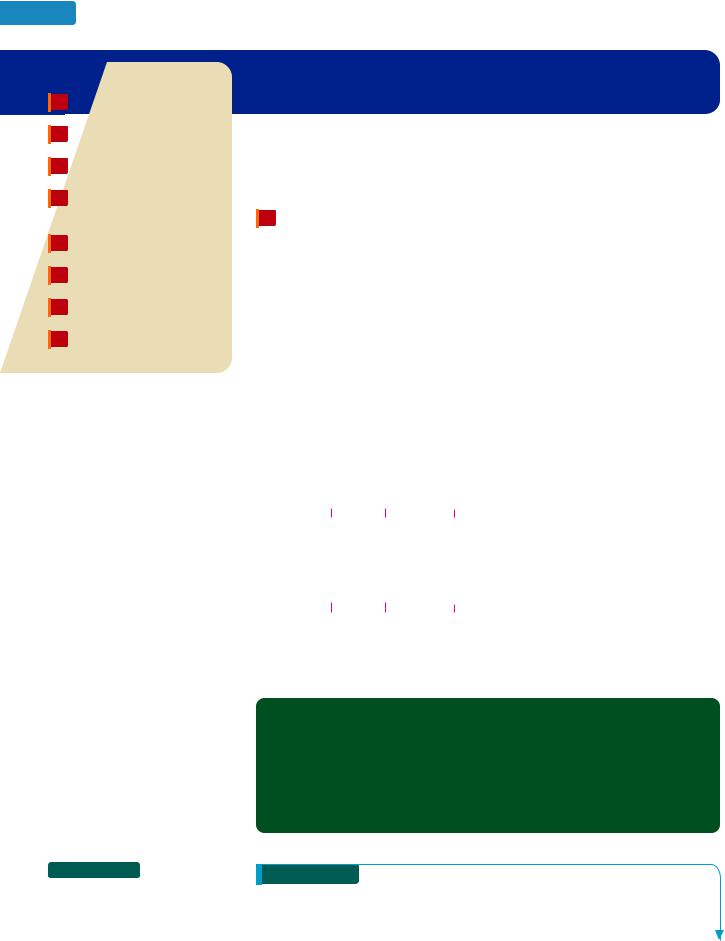
344 Chapter 4 Decimals
Objectives |
S E C T I O N 4.3 |
1Multiply decimals.
2Multiply decimals by powers of 10.
3Multiply signed decimals.
4Evaluate exponential expressions that have decimal bases.
5Use the order of operations rule.
6Evaluate formulas.
7Estimate products of decimals.
8Solve application problems by multiplying decimals.
Multiplying Decimals
Since decimal numbers are base-ten numbers, multiplication of decimals is similar to multiplication of whole numbers. However, when multiplying decimals, there is one additional step—we must determine where to write the decimal point in the product.
1 Multiply decimals.
To develop a rule for multiplying decimals, we will consider the multiplication 0.3 0.17 and find the product in a roundabout way. First, we write 0.3 and 0.17 as fractions and multiply them in that form. Then we express the resulting fraction as a decimal.
0.3 0.17 |
3 |
|
|
17 |
|
Express the decimals 0.3 and 0.17 as fractions. |
|||||
10 |
100 |
||||||||||
|
3 |
|
17 |
|
Multiply the numerators. |
|
|
|
|||
10 |
|
100 |
|
Multiply the denominators. |
|
|
|
||||
|
51 |
|
|
|
|
|
|
|
|
||
1,000 |
|
|
|
|
|
|
|||||
0.051 |
|
|
Write the resulting fraction |
51 |
|
as a decimal. |
|||||
1,000 |
|||||||||||
|
|
|
|
|
|
|
|
|
|||
From this example, we can make observations about multiplying decimals.
• The digits in the answer are found by multiplying 3 and 17.
0.3 |
0.17 |
0.051 |
||
} |
} |
} |
||
|
|
|
|
|
|
|
3 17 51 |
|
|
•The answer has 3 decimal places. The sum of the number of decimal places in the factors 0.3 and 0.17 is also 3.
0.3 |
0.17 |
0.051 |
||
} |
} |
} |
||
|
|
|
|
|
1 decimal |
2 decimal |
3 decimal |
||
place |
places |
places |
||
These observations illustrate the following rule for multiplying decimals.
 Self Check 1
Self Check 1
Multiply: 2.7 4.3
Now Try Problem 9
Multiplying Decimals
To multiply two decimals:
1.Multiply the decimals as if they were whole numbers.
2.Find the total number of decimal places in both factors.
3.Insert a decimal point in the result from step 1 so that the answer has the same number of decimal places as the total found in step 2.
EXAMPLE 1 Multiply: 5.9 3.4
Strategy We will ignore the decimal points and multiply 5.9 and 3.4 as if they were whole numbers. Then we will write a decimal point in that result so that the final answer has two decimal places.

WHY Since the factor 5.9 has 1 decimal place, and the factor 3.4 has 1 decimal place, the product should have 1 1 2 decimal places.
Solution We write the multiplication in vertical form and proceed as follows:
Vertical form |
5.9 |
|
|
|
|
3.4 |
|
|
|
|
|
|
|
|
|
|
236 |
|
|
|
|
1770 |
|
|
|
|
20.06 |
|
|
|
|
|
|
|
Thus, 5.9 3.4 20.06.
1 decimal place v The answer will have
1 decimal place 1 1 2 decimal places.
Move 2 places from the right to the left and insert a decimal point in the answer.
The Language of Mathematics Recall the vocabulary of multiplication.
5.9 Factor
3.4 Factor
236 v
Partial products
1770
20.06 |
|
|
Product |
Success Tip When multiplying decimals, we do not need to line up the decimal points, as the next example illustrates.
EXAMPLE 2 Multiply: 1.3(0.005)
Strategy We will ignore the decimal points and multiply 1.3 and 0.005 as if they were whole numbers. Then we will write a decimal point in that result so that the final answer has four decimal places.
WHY Since the factor 1.3 has 1 decimal place, and the factor 0.005 has 3 decimal places, the product should have 1 3 4 decimal places.
Solution Since many students find vertical form multiplication of decimals easier if the decimal with the smaller number of nonzero digits is written on the bottom, we will write 0.005 under 1.3.
1.3 |
|
|
1 decimal place |
v The answer will have |
|
||
0.005 |
|
|
3 decimal places |
1 3 4 decimal places. |
|
||
0.0065 |
|
|
Write 2 placeholder zeros in front of 6. Then move 4 places from |
|
|||
|
|
|
|
||||
|
|
|
|
|
|||
|
|
|
|
the right to the left and insert a decimal point in the answer. |
|
||
Thus, 1.3(0.005) 0.0065. |
|
|
|||||
|
|
||||||
|
|
||||||
|
EXAMPLE 3 |
Multiply: |
234(5.1) |
|
|||
|
|
||||||
Strategy We will ignore the decimal point and multiply 234 and 5.1 as if they were whole numbers. Then we will write a decimal point in that result so that the final answer has one decimal place.
WHY Since the factor 234 has 0 decimal places, and the factor 5.1 has 1 decimal place, the product should have 0 1 1 decimal place.
|
4.3 Multiplying Decimals |
345 |
|
|
|
|
|
|
 Self Check 2
Self Check 2
Multiply: (0.0002)7.2
Now Try Problem 13
 Self Check 3
Self Check 3
Multiply: 178(4.7)
Now Try Problem 17
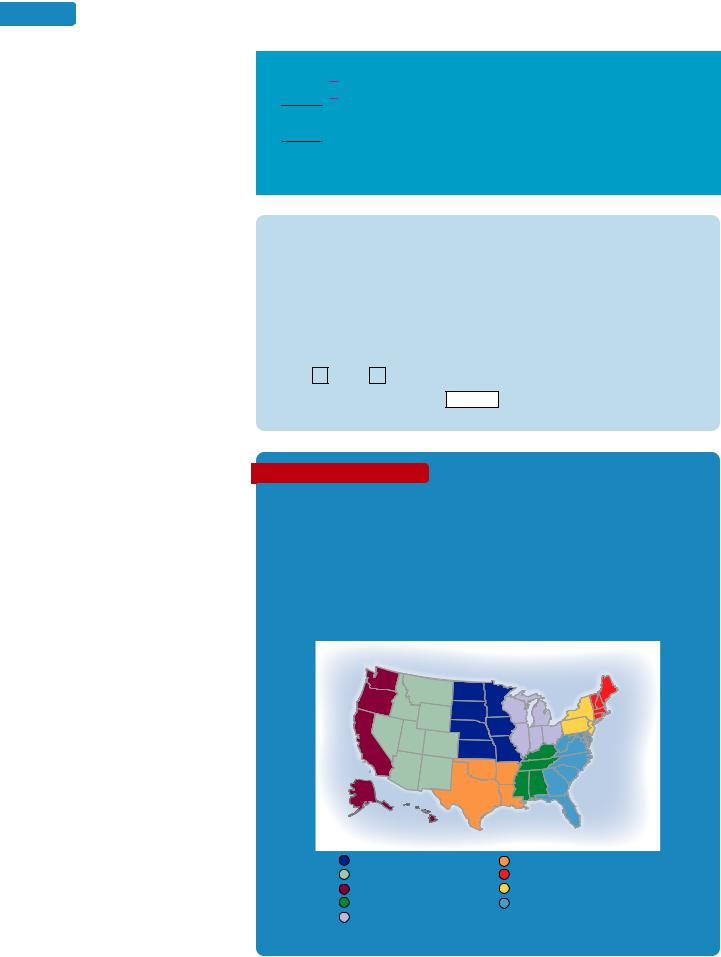
346 |
Chapter 4 Decimals |
Solution We write the multiplication in vertical form, with 5.1 under 234.
2345.1
23 4
1170 0
1193.4
No decimal places |
|
The answer will have |
1 decimal place |
v |
0 1 1 decimal place. |
Move 1 place from the right to the left and insert a decimal point in the answer.
Thus, 234(5.1) 1,193.4.
Using Your CALCULATOR Multiplying Decimals
When billing a household, a gas company converts the amount of natural gas used to units of heat energy called therms. The number of therms used by a household in one month and the cost per therm are shown below.
Customer charge . . . . . . . . . . . . . . . . . . . . . . . . . . . . . . . . . . 39 therms @ $0.72264
To find the total charges for the month, we multiply the number of therms by the cost per therm: 39 0.72264.
39 |
|
.72264 |
|
28.18296 |
28.18296 |
On some calculator models, the ENTER key is pressed to display the product. Rounding to the nearest cent, we see that the total charge is $28.18.
THINK IT THROUGH Overtime
“Employees covered by the Fair Labor Standards Act must receive overtime pay for hours worked in excess of 40 in a workweek of at least 1.5 times their regular rates of pay.”
United States Department of Labor
The map of the United States shown below is divided into nine regions. The average hourly wage for private industry workers in each region is also listed in the legend below the map. Find the average hourly wage for the region where you live. Then calculate the corresponding average hourly overtime wage for that region.
Legend |
West North Central: $17.42 |
West South Central: $17.17 |
|
Mountain: $17.93 |
New England: $22.38 |
|
Pacific: $21.68 |
Middle Atlantic: $21.31 |
|
East South Central: $16.58 |
South Atlantic: $18.34 |
|
East North Central: $18.82 |
|
|
|
|
(Source: Bureau of Labor Statistics, National Compensation Survey, 2008)

4.3 Multiplying Decimals |
347 |
2 Multiply decimals by powers of 10.
The numbers 10,100,and 1,000 are called powers of 10, because they are the results when we evaluate 101, 102, and 103. To develop a rule to find the product when multiplying a decimal by a power of 10, we multiply 8.675 by three different powers of 10.
Multiply: 8.675 10 |
Multiply: 8.675 100 |
Multiply: 8.675 1,000 |
||||||||||
|
|
|
|
|
|
8.675 |
|
|
|
|
8.675 |
|
|
|
8.675 |
|
|
|
|
|
1000 |
|
|||
|
|
|
|
100 |
|
|
||||||
|
10 |
|
|
|
|
|
0000 |
|
||||
|
|
|
0000 |
|
|
|
|
|
||||
|
|
0000 |
|
|
|
|
|
|
|
00000 |
|
|
|
|
|
|
|
00000 |
|
|
|
|
|
||
|
|
86750 |
|
|
|
|
|
|
000000 |
|
||
|
|
|
|
867500 |
|
|
|
|
|
|||
|
|
|
|
|
|
|
|
|
|
|
|
|
|
|
86.750 |
|
|
|
|
|
|
8675000 |
|
||
|
|
|
|
867.500 |
|
|
|
|
|
|||
|
|
|
|
|
|
|
|
|
|
8675.000 |
|
|
|
|
|
|
|
|
|
|
|
|
|
|
|
When we inspect the answers, the decimal point in the first factor 8.675 appears to be moved to the right by the multiplication process. The number of decimal places it moves depends on the power of 10 by which 8.675 is multiplied.
One zero in 10 Two zeros in 100
8.675 10 86.75 |
8.675 100 867.5 |
|
|
It moves 1 place |
It moves 2 places |
to the right. |
to the right. |
These observations illustrate the following rule.
Three zeros in 1,000
8.675 1,000 8675
It moves 3 places to the right.
Multiplying a Decimal by 10, 100, 1,000, and So On
To find the product of a decimal and 10, 100, 1,000, and so on, move the decimal point to the right the same number of places as there are zeros in the power of 10.
EXAMPLE 4 Multiply: a. 2.81 10 b. 0.076(10,000)
Strategy For each multiplication, we will identify the factor that is a power of 10, and count the number of zeros that it has.
WHY To find the product of a decimal and a power of 10 that is greater than 1, we move the decimal point to the right the same number of places as there are zeros in the power of 10.
Solution
a. 2.81 10 28.1 Since 10 has 1 zero, move the decimal point 1 place to the right.
b. 0.076(10,000) |
0760. |
Since 10,000 has 4 zeros, move the decimal point 4 places |
|
|
|
to the right. Write a placeholder zero (shown in blue). |
|
|
|
|
|
|
760 |
|
|
|
|
Numbers such as 10, 100, and 1,000 are powers of 10 that are greater than 1. There are also powers of 10 that are less than 1, such as 0.1, 0.01, and 0.001.To develop a rule to find the product when multiplying a decimal by one tenth, one hundredth, one thousandth, and so on, we will consider three examples:
Multiply: 5.19 0.1 |
Multiply: 5.19 0.01 |
Multiply: 5.19 0.001 |
||||||
5.19 |
5.19 |
5.19 |
||||||
|
0.1 |
0.01 |
|
0.001 |
|
|||
|
|
|
|
|
|
|
|
|
|
0.519 |
0.0519 |
0.00519 |
|
||||
 Self Check 4
Self Check 4
Multiply:
a.0.721 100
b.6.08(1,000)
Now Try Problems 21 and 23
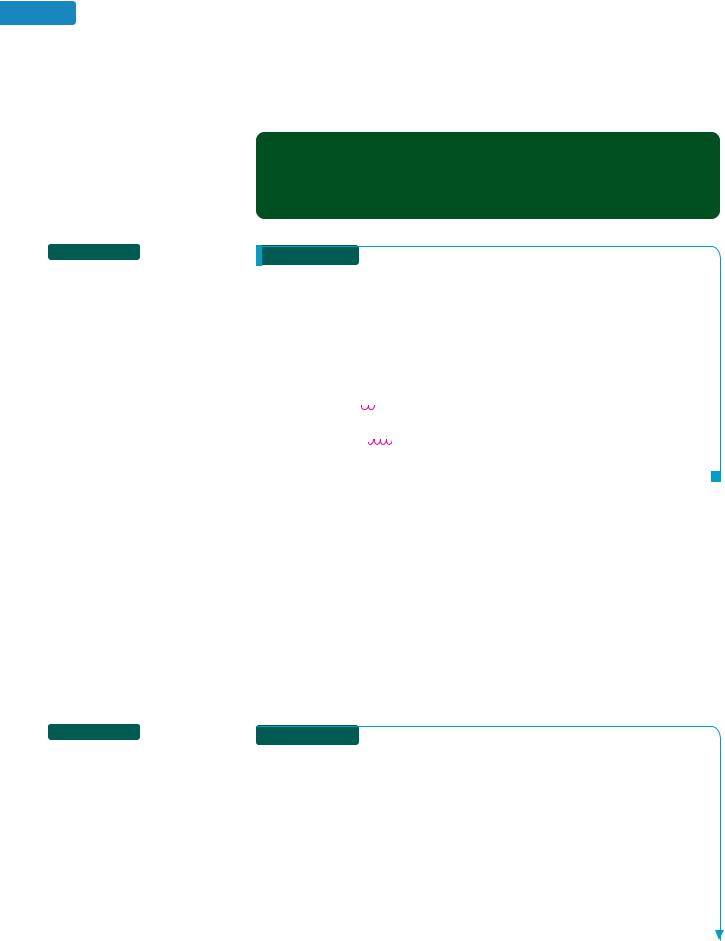
348 |
Chapter 4 Decimals |
When we inspect the answers, the decimal point in the first factor 5.19 appears to be moved to the left by the multiplication process. The number of places that it moves depends on the power of ten by which it is multiplied.
These observations illustrate the following rule.
 Self Check 5
Self Check 5
Multiply:
a.0.1(129.9)
b.0.002 0.00001
Now Try Problems 25 and 27
 Self Check 6
Self Check 6
Write each number in standard notation:
a.567.1 million
b.50.82 billion
c.4.133 trillion
Now Try Now Try Problems 29, 31, and 33
Multiplying a Decimal by 0.1, 0.01, 0.001, and So On
To find the product of a decimal and 0.1, 0.01, 0.001, and so on, move the decimal point to the left the same number of decimal places as there are in the power of 10.
EXAMPLE 5 Multiply: a. 145.8 0.01 b. 9.76(0.0001)
Strategy For each multiplication, we will identify the factor of the form 0.1, 0.01, and 0.001, and count the number of decimal places that it has.
WHY To find the product of a decimal and a power of 10 that is less than 1, we move the decimal point to the left the same number of decimal places as there are in the power of 10.
Solution
a. 145.8 0.01 1.458 |
Since 0.01 has two decimal places, move the decimal point |
|
in 145.8 two places to the left. |
|
b. 9.76(0.0001) 0.000976 Since 0.0001 has four decimal places, move the decimal point in 9.76 four places to the left. This requires that
three placeholder zeros (shown in blue) be inserted in front of the 9.
Quite often, newspapers, websites, and television programs present large numbers in a shorthand notation that involves a decimal in combination with a place-value column name. For example,
•As of December 31, 2008, Sony had sold 21.3 million Playstation 3 units worldwide. (Source: Sony Computer Entertainment)
•Boston’s Big Dig was the most expensive single highway project in U.S. history. It cost about $14.63 billion. (Source: Roadtraffic-technology.com)
•The distance that light travels in one year is about 5.878 trillion miles. (Source: Encyclopaedia Britannica)
We can use the rule for multiplying a decimal by a power of ten to write these large numbers in standard form.
|
EXAMPLE 6 |
Write each number in standard notation: |
|
a. 21.3 million |
b. 14.63 billion |
c. 5.9 trillion |
|
Strategy We will express each of the large numbers as the product of a decimal and a power of 10.
WHY Then we can use the rule for multiplying a decimal by a power of 10 to find their product. The result will be in the required standard form.
Solution
a.21.3 million 21.3 1 million
21.3 1,000,000 Write 1 million in standard form.
21,300,000 |
Since 1,000,000 has six zeros, move the |
|
decimal point in 21.3 six places to the right. |

b.14.63 billion 14.63 1 billion
14.63 1,000,000,000 Write 1 billion in standard form.
14,630,000,000 |
Since 1,000,000,000 has nine zeros, move |
|
the decimal point in 14.63 nine places to the |
|
right. |
c.5.9 trillion 5.9 1 trillion
5.9 1,000,000,000,000 Write 1 trillion in standard form.
5,900,000,000,000 |
Since 1,000,000,000,000 has twelve zeros, |
|
|
move the decimal point in 5.9 twelve places to |
|
|
the right. |
|
|
|
3 Multiply signed decimals.
The rules for multiplying integers also hold for multiplying signed decimals. The product of two decimals with like signs is positive, and the product of two decimals with unlike signs is negative.
EXAMPLE 7 Multiply: a. 1.8(4.5) b. ( 1,000)( 59.08)
Strategy In part a, we will use the rule for multiplying signed decimals that have different (unlike) signs. In part b, we will use the rule for multiplying signed decimals that have the same (like) signs.
WHY In part a, one factor is negative and one is positive. In part b, both factors are negative.
Solution
a. Find the absolute values: 0 1.8 0 1.8 and 04.5 0 4.5. Since the decimals have unlike signs, their product is negative.
1.8(4.5) 8.1 |
Multiply the absolute values, 1.8 and 4.5, to get 8.1. |
1.8 |
|||
4.5 |
|||||
|
|
Then make the final answer negative. |
|||
|
|
90 |
|||
|
|
|
|||
|
|
|
720 |
||
|
|
|
|
8.10 |
|
|
|
|
|
||
b.Find the absolute values: 0 1,000 0 1,000 and 0 59.08 0 59.08. Since the decimals have like signs, their product is positive.
( 1,000)( 59.08) 1,000(59.08) Multiply the absolute values, 1,000 and
59,080 |
59.08. Since 1,000 has 3 zeros, move |
|
the decimal point in 59.08 3 places to |
|
|
|
|
|
|
the right. Write a placeholder zero. The |
|
|
answer is positive. |
|
|
|
|
|
|
4 Evaluate exponential expressions that have decimal bases.
We have evaluated exponential expressions that have whole number bases, integer bases, and fractional bases. The base of an exponential expression can also be a positive or a negative decimal.
EXAMPLE 8 Evaluate: a. (2.4)2 b. ( 0.05)2
Strategy We will write each exponential expression as a product of repeated factors, and then perform the multiplication.This requires that we identify the base and the exponent.
WHY The exponent tells the number of times the base is to be written as a factor.
4.3 Multiplying Decimals |
349 |
 Self Check 7
Self Check 7
Multiply:
a.6.6( 5.5)
b.44.968( 100)
Now Try Problems 37 and 41
 Self Check 8
Self Check 8
Evaluate:
a.( 1.3)2
b.(0.09)2
Now Try Problems 45 and 47
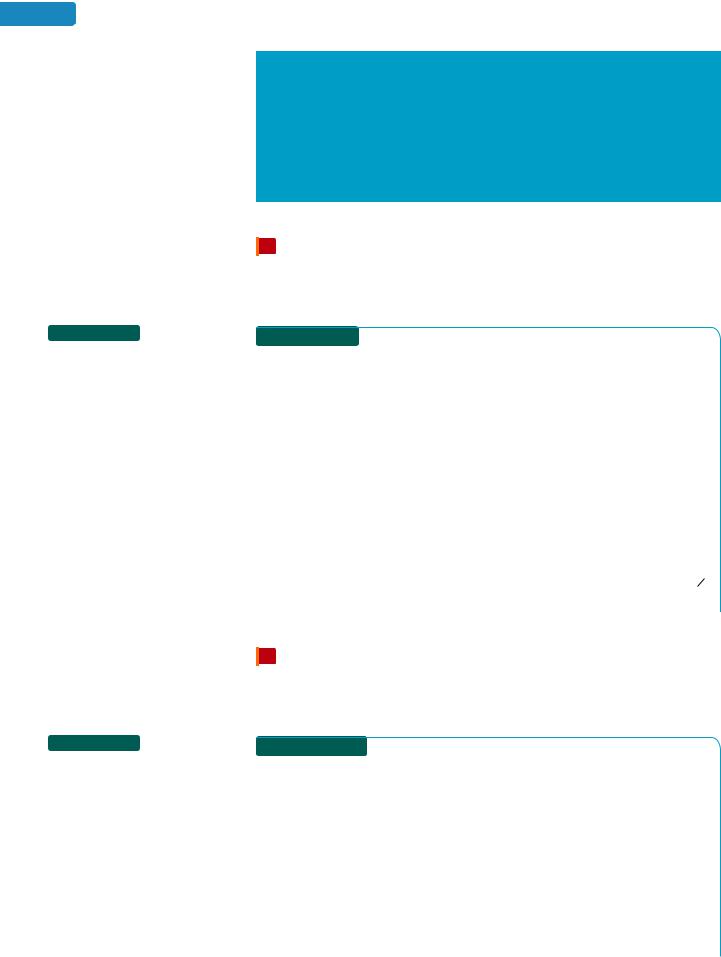
350 |
Chapter 4 Decimals |
 Self Check 9
Self Check 9
Evaluate:
2 0 4.4 5.6 0 ( 0.8)2
Now Try Problem 49
 Self Check 10
Self Check 10
Evaluate V 1.3pr3 for p 3.14 and r 3.
Now Try Problem 53
Solution
a. (2.4)2 2.4 2.4 |
The base is 2.4 and the exponent is 2. Write the base |
|
|
|
|
2.4 |
|
|
|
|
|
||||||
|
as a factor 2 times. |
|
|
|
2.4 |
|
||
5.76 |
Multiply the decimals. |
|
|
|
|
96 |
|
|
|
|
|
|
480 |
|
|||
|
|
|
|
|
|
|
||
|
|
|
|
|
|
5.76 |
|
|
b. ( 0.05)2 ( 0.05)( 0.05) The base is 0.05 and the exponent is 2. |
|
|
|
|
0.05 |
|||
|
Write the base as a factor 2 times. |
|
|
|
0.05 |
|||
0.0025 |
|
|
|
0.0025 |
||||
Multiply the decimals. The product of two |
||||||||
|
|
|
|
|||||
decimals with like signs is positive.
5 Use the order of operations rule.
Recall that the order of operations rule is used to evaluate expressions that involve more than one operation.
|
EXAMPLE 9 |
Evaluate: |
(0.6) |
2 |
5 |
0 3.6 |
1.9 0 |
Strategy The absolute value bars are grouping symbols. We will perform the addition within them first.
WHY By the order of operations rule, we must perform all calculations within parentheses and other grouping symbols (such as absolute value bars) first.
Solution |
|
|
|
|
|
(0.6)2 5 0 3.6 1.9 0 |
|
|
|
|
|
(0.6)2 5 0 1.7 0 |
Do the addition within the absolute |
|
2 |
16 |
|
|
|
||||
|
3.6 |
|
|||
|
value symbols. Use the rule for adding |
|
1.9 |
|
|
|
two decimals with different signs. |
|
1.7 |
|
|
(0.6)2 5(1.7) |
Simplify: 0 1.7 0 1.7. |
|
3 |
|
|
|
1.7 |
|
|||
0.36 5(1.7) |
Evaluate: (0.6)2 0.36. |
|
5 |
|
|
0.36 8.5 |
Do the multiplication: 5(1.7) 8.5. |
|
8.5 |
|
|
|
|
4 10 |
|
||
8.14 |
Use the rule for adding two decimals |
|
8.5 0 |
|
|
|
0.36 |
|
|||
|
with different signs. |
|
|
||
|
|
8.14 |
|
||
|
|
|
|
||
6 Evaluate formulas.
Recall that to evaluate a formula, we replace the letters (called variables) with specific numbers and then use the order of operations rule.
 EXAMPLE 10 Evaluate the formula S 6.28r(h r) for h 3.1 and r 6.
EXAMPLE 10 Evaluate the formula S 6.28r(h r) for h 3.1 and r 6.
Strategy In the given formula, we will replace the letter r with 6 and h with 3.1.
WHY Then we can use the order of operations rule to find the value of the expression on the right side of the symbol.
Solution
S 6.28r (h r) |
6.28r (h r) means 6.28 r (h r). |
|
37.68 |
|
|
|
|||
6.28(6)(3.1 6) |
Replace r with 6 and h with 3.1. |
|
9.1 |
|
|
3768 |
|
||
6.28(6)(9.1) |
|
|
|
|
Do the addition within the parentheses. |
|
339120 |
|
|
37.68(9.1) |
Do the multiplication: 6.28(6) 37.68. |
|
342.888 |
|
|
|
|
||
342.888 |
Do the multiplication. |
|
|
|
|
|
|
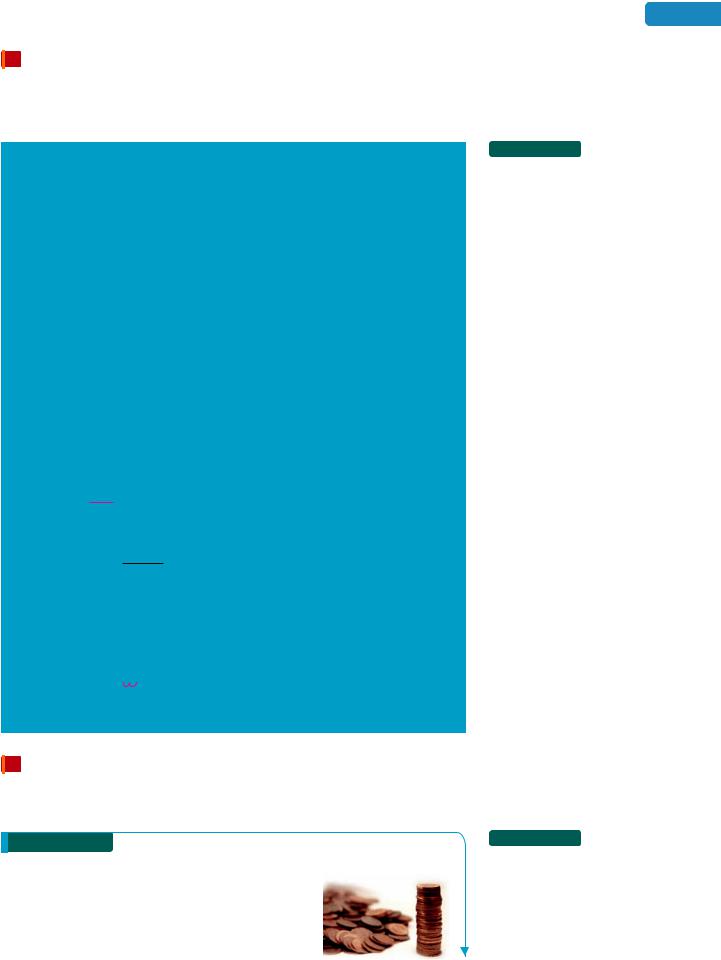
7 Estimate products of decimals.
Estimation can be used to check the reasonableness of an answer to a decimal multiplication.There are several ways to estimate,but the objective is the same:Simplify the numbers in the problem so that the calculations can be made easily and quickly.
 EXAMPLE 11
EXAMPLE 11
a.Estimate using front-end rounding: 27 6.41
b.Estimate by rounding each factor to the nearest tenth: 13.91 5.27
c.Estimate by rounding: 0.1245(101.4)
Strategy We will use rounding to approximate the factors. Then we will find the product of the approximations.
WHY Rounding produces factors that contain fewer digits. Such numbers are easier to multiply.
Solution
a.To estimate 27 6.41 by front-end rounding, we begin by rounding both factors to their largest place value.
27 |
|
|
30 |
|
Round to the nearest ten. |
6.41 |
|
|
6 |
Round to the nearest one. |
|
|
|
|
|
|
|
|
|
|
180 |
|
|
The estimate is 180. If we calculate 27 6.41, the product is exactly 173.07. The estimate is close: It’s about 7 more than 173.07.
b. To estimate 13.91 5.27, we will round both decimals to the nearest tenth.
13.9113.9 Round to the nearest tenth.
5.27 |
|
|
5.3 Round to the nearest tenth. |
|
|
|
|
|
|
417
6950
73.67
The estimate is 73.67. If we calculate 13.91 5.27, the product is exactly 73.3057. The estimate is close: It’s just slightly more than 73.3057.
c.Since 101.4 is approximately 100, we can estimate 0.1245(101.4) using 0.1245(100).
0.1245(100) 12.45 Since 100 has two zeros, move the decimal point in
0.1245 two places to the right.
The estimate is 12.45. If we calculate 0.1245(101.4), the product is exactly 12.6243. Note that the estimate is close: It’s slightly less than 12.6243.
8 Solve application problems by multiplying decimals.
Application problems that involve repeated addition are often more easily solved using multiplication.
Coins Banks wrap pennies in rolls of 50 coins. If a penny is 1.55 millimeters thick, how tall is a stack of 50 pennies?
Analyze |
|
Cookey/Dreamstime.com |
|
• How tall is a stack of 50 pennies? |
Find |
||
• |
There are 50 pennies in a stack. |
Given |
|
• |
A penny is 1.55 millimeters thick. |
Given |
|
4.3 Multiplying Decimals |
351 |
 Self Check 11
Self Check 11
a.Estimate using front-end rounding: 4.337 65
b.Estimate by rounding the factors to the nearest tenth: 3.092 11.642
c.Estimate by rounding: 0.7899(985.34)
Now Try Problems 61 and 63
 Self Check 12
Self Check 12
COINS Banks wrap nickels in rolls of 40 coins. If a nickel is 1.95 millimeters thick, how tall is a stack of 40 nickels?
Now Try Problem 97
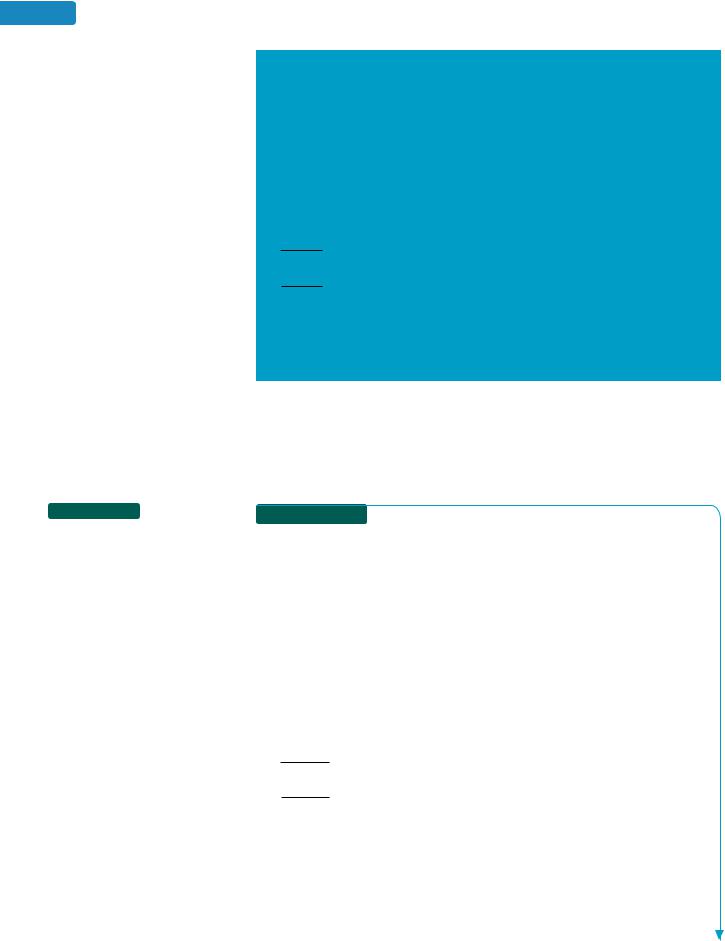
352 |
Chapter 4 Decimals |
Form The height (in millimeters) of a stack of 50 pennies, each of which is 1.55 thick, is the sum of fifty 1.55’s. This repeated addition can be calculated more simply by multiplication.
 Self Check 13
Self Check 13
WEEKLY EARNINGS A pharmacy assistant’s basic workweek is 40 hours. After her daily shift is over, she can work overtime
at a rate of 1.5 times her regular rate of $15.90 per hour. How much money will she earn in a week if she works 4 hours of overtime?
Now Try Problem 113
The height of a |
is equal to |
the thickness |
times |
the number of |
|
stack of pennies |
of one penny |
pennies in the stack. |
|||
|
|
||||
|
|
|
|
|
|
The height of |
|
1.55 |
|
50 |
|
stack of pennies |
|||||
|
|
|
|
Solve Use vertical form to perform the multiplication:
1.5550
000
7750
77.50
State A stack of 50 pennies is 77.5 millimeters tall.
Check We can estimate to check the result. If we use 2 millimeters to approximate the thickness of one penny, then the height of a stack of 50 pennies is about 2 50 millimeters 100 millimeters. The result, 77.5 mm, seems reasonable.
Sometimes more than one operation is needed to solve a problem involving decimals.
 A cashier’s basic workweek is 40 hours. After his daily shift is over, he can work overtime at a rate 1.5 times his regular rate of $13.10 per hour. How much money will he earn in a week if he works 6 hours of overtime?
A cashier’s basic workweek is 40 hours. After his daily shift is over, he can work overtime at a rate 1.5 times his regular rate of $13.10 per hour. How much money will he earn in a week if he works 6 hours of overtime?
Analyze
• A cashier’s basic workweek is 40 hours. Given
•His overtime pay rate is 1.5 times his regular rate of $13.10 per hour. Given
•How much money will he earn in a week if he works his regular shift
and 6 hours overtime? |
Find |
Form To find the cashier’s overtime pay rate, we multiply 1.5 times his regular pay rate, $13.10.
13.101.5
6550
13100
19.650
The cashier’s overtime pay rate is $19.65 per hour.
We now translate the words of the problem to numbers and symbols.
The total amount the |
is equal to |
40 |
times |
his regular |
plus |
the number of |
times |
his overtime |
|
cashier earns in a week |
hours |
pay rate |
overtime hours |
rate. |
|||||
|
|
|
|
||||||
|
|
|
|
|
|
|
|
|
|
The total amount the |
|
40 |
|
$13.10 |
|
6 |
|
$19.65 |
|
cashier earns in a week |
|||||||||
|
|
|
|
|
|
|
|

4.3 Multiplying Decimals |
353 |
Solve We will use the rule for the order of operations to evaluate the expression:
40 13.10 6 19.65 524.00 |
117.90 |
Do the multiplication first. |
641.90 |
|
Do the addition. |
State The cashier will earn a total of $641.90 for the week.
13.1040
0000
5240
524.00
5 3 3
19.65
6
117.90
1
524.00
117.90
641.90
Check We can use estimation to check. The cashier works 40 hours per week for approximately $13 per hour to earn about 40 $13 $520. His 6 hours of overtime at approximately $20 per hour earns him about 6 $20 $120. His total earnings that week are about $520 $120 $640. The result, $641.90, seems reasonable.
|
ANSWERS TO SELF CHECKS |
|
|
|
|
|
|
|
|
|
|||||
|
|
|
|
|
|
|
|
|
|
||||||
|
1. |
11.61 |
2. |
0.00144 |
3. |
836.6 |
4. a. |
72.1 b. |
6,080 |
5. a. |
12.99 b. |
0.00000002 |
|||
|
6. |
a. |
567,100,000 b. |
50,820,000,000 |
c. 4,133,000,000,000 |
7. |
a. 36.3 |
b. 4,496.8 |
|||||||
|
8. |
a. |
1.69 |
b. 0.0081 |
9. |
1.76 |
10. |
110.214 |
11. a. |
280 |
b. |
35.96 |
c. |
789.9 |
|
|
12. 78 mm |
13. $731.40 |
|
|
|
|
|
|
|
|
|
||||
|
|
|
|
|
|
|
|
|
|
|
|
|
|
|
|
S E C T I O N 4.3 STUDY SET
 VOCABULARY
VOCABULARY
Fill in the blanks.
1.In the multiplication problem shown below, label each factor, the partial products, and the product.
3.4
2.6 |
|
|
|
|
204 |
|
|
|
|
|
|
|
||
|
|
|
||
680 |
|
|
|
|
|
|
|
||
|
|
|
||
8.84 |
|
|
|
|
|
|
|
||
|
|
|
||
|
|
|
|
|
2. Numbers such as 10, 100, and 1,000 are called of 10.
 CONCEPTS
CONCEPTS
Fill in the blanks.
3.Insert a decimal point in the correct place for each product shown below. Write placeholder zeros, if necessary.
a. |
3.8 |
b. |
1.79 |
|
|
0.6 |
|
8.1 |
|
|
228 |
|
|
|
c. |
2.0 |
d. |
0.013 |
|
|
||||
|
7 |
|
0.02 |
|
|
140 |
|
0026 |
|
4.Fill in the blanks.
a.To find the product of a decimal and 10, 100, 1,000, and so on, move the decimal point to the
the same number of places as there are zeros in the power of 10.
b.To find the product of a decimal and 0.1, 0.01, 0.001, and so on, move the decimal point to the
the same number of places as there are in the power of 10.
5.Determine whether the sign of each result is positive or negative. You do not have to find the product.
a.7.6( 1.8)
b.4.09 2.274
6.a. When we move its decimal point to the right, does a decimal number get larger or smaller?
b.When we move its decimal point to the left, does a decimal number get larger or smaller?
 NOTATION
NOTATION
7.a. List the first five powers of 10 that are greater than 1.
b.List the first five powers of 10 that are less than 1.
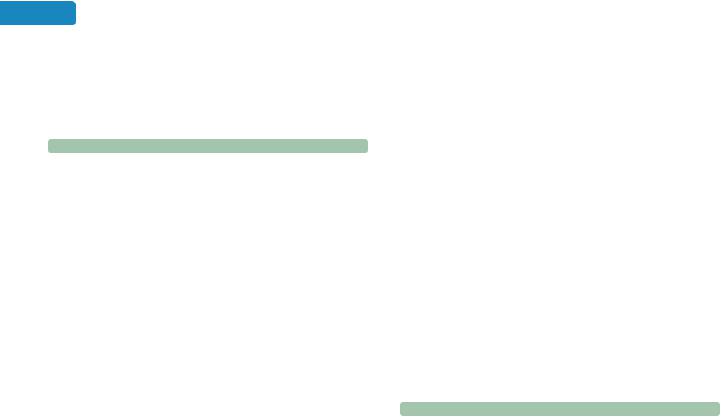
354 |
Chapter 4 Decimals |
8.Write each number in standard notation.
a.one million
b.one billion
c.one trillion
 GUIDED PRACTICE
GUIDED PRACTICE
Multiply. See Example 1. |
|
|
|
||
9. |
4.8 6.2 |
10. |
3.5 9.3 |
||
11. |
5.6(8.9) |
12. |
7.2(8.4) |
||
Multiply. See Example 2. |
|
|
|
||
13. |
0.003(2.7) |
14. |
0.002(2.6) |
||
15. |
5.8 |
16. |
8.7 |
||
|
0.009 |
|
0.004 |
||
Multiply. See Example 3. |
|
|
|
||
17. |
179(6.3) |
18. |
225(4.9) |
||
19. |
316 |
|
20. |
527 |
|
|
7.4 |
|
|
3.7 |
|
Multiply. See Example 4. |
|
|
|
||
21. |
6.84 100 |
22. |
2.09 100 |
||
23. |
0.041(10,000) |
24. |
0.034(10,000) |
||
Multiply. See Example 5. |
|
|
|
||
25. |
647.59 0.01 |
26. |
317.09 0.01 |
||
27. |
1.15(0.001) |
28. |
2.83(0.001) |
||
Write each number in standard notation. See Example 6.
29. |
14.2 million |
30. |
33.9 million |
31. |
98.2 billion |
32. |
80.4 billion |
33. |
1.421 trillion |
34. |
3.056 trillion |
35. |
657.1 billion |
36. |
422.7 billion |
Multiply. See Example 7. |
|
|
|
37. |
1.9(7.2) |
38. |
5.8(3.9) |
39. |
3.3( 1.6) |
40. |
4.7( 2.2) |
41. |
( 10,000)( 44.83) |
42. |
( 10,000)( 13.19) |
43. |
678.231( 1,000) |
44. |
491.565( 1,000) |
Evaluate each expression. See Example 8. |
|||
45. |
(3.4)2 |
46. |
(5.1)2 |
47. |
( 0.03)2 |
48. |
( 0.06)2 |
Evaluate each expression. See Example 9.
49.( 0.2)2 4 0 2.3 1.5 0
50.( 0.3)2 6 0 6.4 1.7 0
51.( 0.8)2 7 0 5.1 4.8 0
52.( 0.4)2 6 0 6.2 3.5 0
Evaluate each formula. See Example 10.
53. A P Prt for P 85.50, r 0.08, and t 5
54. A P Prt for P 99.95, r 0.05, and t 10
55.A lw for l 5.3 and w 7.2
56.A 0.5bh for b 7.5 and h 6.8
57.P 2l 2w for l 3.7 and w 3.6
58. P a b c for a 12.91, b 19, and c 23.6
59.C 2pr for p 3.14 and r 2.5
60.A pr2 for p 3.14 and r 4.2
Estimate each product using front-end rounding.
See Example 11.
61. 46 5.3 |
62. 37 4.29 |
Estimate each product by rounding the factors to the nearest tenth. See Example 11.
63. 17.11 3.85 64. 18.33 6.46
 TRY IT YOURSELF
TRY IT YOURSELF
Perform the indicated operations. |
|
||
65. |
0.56 0.33 |
66. |
0.64 0.79 |
67. |
( 1.3)2 |
68. |
( 2.5)2 |
69.( 0.7 0.5)(2.4 3.1)
70.( 8.1 7.8)(0.3 0.7)
71. |
0.008 |
72. |
0.003 |
|
0.09 |
|
0.09 |
73. |
0.2 1,000,000 |
74. |
1,000,000 1.9 |
75. |
( 5.6)( 2.2) |
76. |
( 7.1)( 4.1) |
77. |
4.6(23.4 19.6) |
78. |
6.9(9.8 8.9) |
79. |
( 4.9)( 0.001) |
80. |
( 0.001)( 7.09) |
81. |
( 0.2)2 2(7.1) |
82. |
( 6.3)(3) (1.2)2 |
83. |
2.13 |
84. |
3.06 |
|
4.05 |
|
1.82 |
85.7(8.1781)
86.5(4.7199)
87.1,000(0.02239)
88.100(0.0897)
89.(0.5 0.6)2( 3.2)
90.( 5.1)(4.9 3.4)2
91.0.2(306)( 0.4)
92.0.3(417)( 0.5)
93.0.01( 0 2.6 6.7 0)2
94.0.01( 0 8.16 9.9 0)2

Complete each table. |
|
|
|
|
95. |
|
96. |
|
|
|
|
|
|
|
Decimal |
Its square |
|
Decimal |
Its cube |
|
|
|
|
|
0.1 |
|
|
0.1 |
|
0.2 |
|
|
0.2 |
|
0.3 |
|
|
0.3 |
|
0.4 |
|
|
0.4 |
|
0.5 |
|
|
0.5 |
|
0.6 |
|
|
0.6 |
|
0.7 |
|
|
0.7 |
|
0.8 |
|
|
0.8 |
|
0.9 |
|
|
0.9 |
|
|
|
|
|
|
 APPLICATIONS
APPLICATIONS
97.REAMS OF PAPER Find the thickness of a 500-sheet ream of copier paper if each sheet is 0.0038 inch thick.
98.MILEAGE CLAIMS Each month, a salesman is reimbursed by his company for any work-related travel that he does in his own car at the rate of $0.445 per mile. How much will the salesman receive if he traveled a total of 120 miles in his car on business in the month of June?
99.SALARIES Use the following formula to determine the annual salary of a recording engineer who works 38 hours per week at a rate of $37.35 per hour. Round the result to the nearest hundred dollars.
Annual |
hourly |
hours |
salary |
rate |
per week 52.2 weeks |
100.PAYCHECKS If you are paid every other week, your monthly gross income is your gross income from one paycheck times 2.17. Find the monthly gross income of a supermarket clerk who earns $1,095.70 every two weeks. Round the result to the nearest cent.
101.BAKERY SUPPLIES A bakery buys various types of nuts as ingredients for cookies. Complete the table by filling in the cost of each purchase.
Type of |
Price |
|
|
nut |
per pound |
Pounds |
Cost |
|
|
|
|
Almonds |
$5.95 |
16 |
|
Walnuts |
$4.95 |
25 |
|
|
|
|
|
4.3 Multiplying Decimals |
355 |
102.NEW HOMES Find the cost to build the home shown below if construction costs are $92.55 per square foot.
House Plan #DP-2203 |
|
|
|
|
|
Square Feet: |
2,291 Sq Ft. |
Width: |
70'70'' |
Bedrooms: |
3 |
Stories: |
Single Story |
Depth: |
64'0'' |
Bathrooms: |
3 |
|
|
|
|
Garage Bays: |
2 |
103.BIOLOGY Cells contain DNA. In humans, it determines such traits as eye color, hair color, and height. A model of DNA appears below. If 1 Å (angstrom) 0.000000004 inch, find the
dimensions of 34 Å, 3.4 Å, and 10 Å, shown in the illustration.
34 Å
3.4 Å
10 Å
104.TACHOMETERS
a.Estimate the decimal number to which the tachometer needle points in the illustration below.
b.What engine speed (in rpm) does the tachometer indicate?
3 |
4 |
5 |
|
||
2 |
|
6 |
1 |
|
7 |
0 |
|
8 |
RPM x 1000

356 |
Chapter 4 Decimals |
105.CITY PLANNING The streets shown in blue on the city map below are 0.35 mile apart. Find the distance of each trip between the two given locations.
a.The airport to the Convention Center
b.City Hall to the Convention Center
c.The airport to City Hall
Airport
Convention Center |
City Hall |
106.RETROFITS The illustration below shows the current widths of the three columns of a freeway overpass. A computer analysis indicated that the width of each column should actually be 1.4 times what it currently is to withstand the stresses of an earthquake. According to the analysis, how wide should each of the columns be?
4.5 ft |
3.5 ft |
2.5 ft |
107.ELECTRIC BILLS When billing a household, a utility company charges for the number of kilowatthours used. A kilowatt-hour (kwh) is a standard measure of electricity. If the cost of 1 kwh is $0.14277, what is the electric bill for a household that uses 719 kwh in a month? Round the answer to the nearest cent.
108.UTILITY TAXES Some gas companies are required to tax the number of therms used each month by the customer. What are the taxes collected on a monthly usage of 31 therms if the tax rate is $0.00566 per therm? Round the answer to the nearest cent.
109.Write each highlighted number in standard form.
a.CONSERVATION The 19.6-million acre
Arctic National Wildlife Refuge is located in the northeast corner of Alaska. (Source: National Wildlife Federation)
b.POPULATION According to projections by the International Programs Center at the U.S. Census Bureau, at 7:16 P.M. eastern time on Saturday, February 25, 2006, the population of the Earth hit
6.5 billion people.
c.DRIVING The U.S. Department of Transportation estimated that Americans drove a total of 3.026 trillion miles in 2008. (Source: Federal Highway Administration)
110.Write each highlighted number in standard form.
a.MILEAGE Irv Gordon, of Long Island, New York, has driven a record 2.6 million miles in his 1966 Volvo P-1800. (Source: autoblog.com)
b.E-COMMERCE Online spending during the 2008 holiday season (November 1 through December 23) was about $25.5 billion. (Source: pcmag.com)
c.FEDERAL DEBT On March 27, 2009, the U.S. national debt was $11.073 trillion. (Source: National Debt Clock)
111.SOCCER A soccer goal is rectangular and measures 24 feet wide by 8 feet high. Major league soccer officials are proposing to increase its width by 1.5 feet and increase its height by 0.75 foot.
a.What is the area of the goal opening now?
b.What would the area be if the proposal is adopted?
c.How much area would be added?
112.SALT INTAKE Studies done by the Centers for Disease Control and Prevention found that the average American eats 3.436 grams of salt each day. The recommended amount is 1.5 grams per day. How many more grams of salt does the average American eat in one week compared with what the Center recommends?
113.CONCERT SEATING Two types of tickets were sold for a concert. Floor seating costs $12.50 a ticket, and balcony seats cost $15.75.
a.Complete the following table and find the receipts from each type of ticket.
b.Find the total receipts from the sale of both types of tickets.
Ticket |
|
Number |
|
type |
Price |
sold |
Receipts |
|
|
|
|
Floor |
|
1,000 |
|
Balcony |
|
100 |
|
|
|
|
|
Copyright 2010 Cengage Learning, Inc. All Rights Reserved. May not be copied, scanned, or duplicated, in whole or in part.
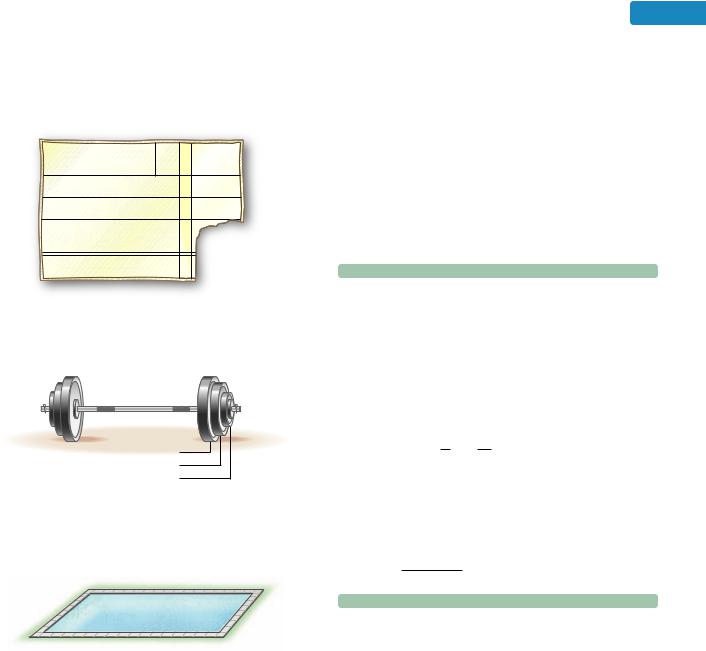
114.PLUMBING BILLS A corner of the invoice for plumbing work is torn. What is the labor charge for the 4 hours of work? What is the total charge (standard service charge, parts, labor)?
Carter Plumbing |
|
Invoice |
100 W. Dalton Ave. |
|
#210 |
Standard service charge |
$ |
25.75 |
Parts |
$ |
38.75 |
Labor: |
|
|
4 hr @ $40.55/hr |
$ |
|
Total charges |
$ |
|
115.WEIGHTLIFTING The barbell is evenly loaded with iron plates. How much plate weight is loaded on the barbell?
45.5 lb
20.5 lb
2.2 lb
116.SWIMMING POOLS Long bricks, called coping, can be used to outline the edge of a swimming pool. How many meters of coping will be needed in the construction of the swimming pool shown?
50 m
30.3 m
117.STORM DAMAGE After a rainstorm, the saturated ground under a hilltop house began to give way. A survey team noted that the house
4.3 Multiplying Decimals |
357 |
dropped 0.57 inch initially. In the next three weeks, the house fell 0.09 inch per week. How far did the house fall during this three-week period?
118.WATER USAGE In May, the water level of a reservoir reached its high mark for the year. During the summer months, as water usage increased, the level dropped. In the months of May and June, it fell 4.3 feet each month. In August, and September, because of high temperatures, it fell another 8.7 feet each month. By the beginning of October, how far below the year’s high mark had the water level fallen?
 WRITING
WRITING
119.Explain how to determine where to place the decimal point in the answer when multiplying two decimals.
120.List the similarities and differences between wholenumber multiplication and decimal multiplication.
121.Explain how to multiply a decimal by a power of 10 that is greater than 1, and by a power of ten that is less than 1.
122.Is it easier to multiply the decimals 0.4 and 0.16 or the fractions 104 and 10016 ? Explain why.
123.Why do we have to line up the decimal points when adding, but we do not have to when multiplying?
124.Which vertical form for the following multiplication do you like better? Explain why.
0.000003 |
2.8 |
2.7 0.000003
 REVIEW
REVIEW
Find the prime factorization of each number. Use exponents in your answer, when helpful.
125. |
220 |
126. |
400 |
127. |
162 |
128. |
735 |
